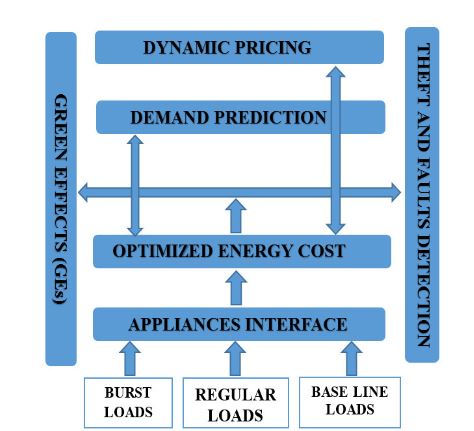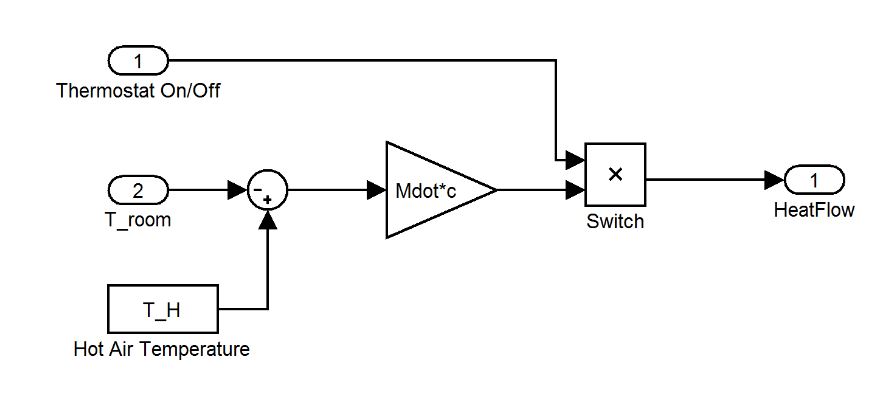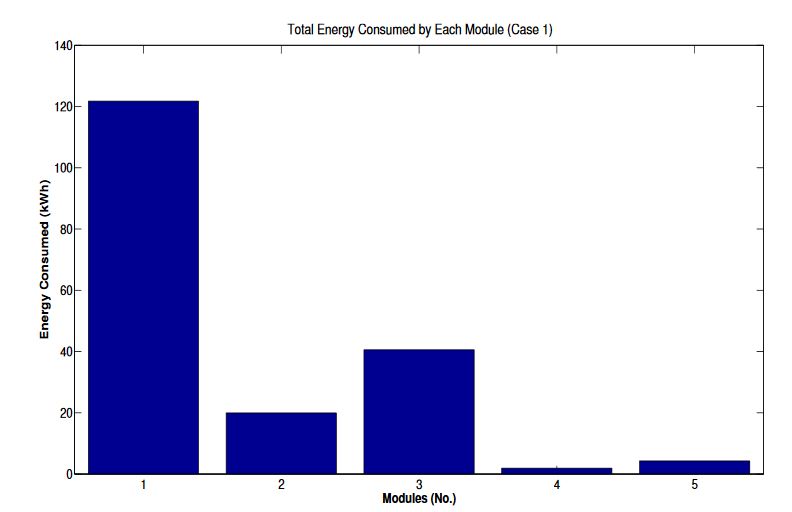ABSTRACT
Demand Side Management (DSM) through optimization of home energy consumption in the smart grid environment is now one of the well-known research areas. Appliance scheduling has been done through many different algorithms to reduce peak load and, consequently, the Peak to Average Ratio (PAR). This paper presents a Comprehensive Home Energy Management Architecture (CHEMA) with integration of multiple appliance scheduling options and enhanced load categorization in a smart grid environment.
The CHEMA model consists of six layers and has been modeled in Simulink with an embedded MATLAB code. A single Knapsack optimization technique is used for scheduling and four different cases of cost reduction are modeled at the second layer of CHEMA. Fault identification and electricity theft control have also been added in CHEMA. Furthermore, carbon footprint calculations have been incorporated in order to make the users aware of environmental concerns. Simulation results prove the effectiveness of the proposed model.
RELATED WORK
Various pricing strategies have been designed for users energy cost minimization. For instance, a day ahead pricing scheme has been used for appliance scheduling in order to minimize total energy cost. Authors proposed a Linear Programming (LP) model to optimize the home energy consumption and total cost. In this model, a full day is divided into equal length time slots with changing prices just like Time of Use (ToU) tariff.
PROPOSED CHEMA AND ITS IMPLEMENTATION

Figure 1. Proposed Comprehensive Home Energy Management Architecture (CHEMA)
These loads include water heaters, space heaters, air conditioners and refrigerators. We have added these basic loads in CHEMA with least impact on user comfort. Our proposed model consists of six layers: Appliance Interface (AI), Optimized Energy Cost (OEC), Theft and Faults Detection (TFD), Green Effects (GEs), Demand Prediction (DP), and Dynamic Pricing. Basic layout of the proposed CHEMA is depicted in Figure 1.

Figure 4. Heater subsystem
The water heater is another important load with thermal storage capability used in CHEMA for energy management. Water heaters are considered the second largest load among household appliances and consume about 30% of the total energy consumed. Electrical energy supplied to water heaters is divided into two parts: one is used for heating of cold water and the other is consumed for compensation of heat losses from tank to ambient.
RESULTS AND DISCUSSION

Figure 17. Aggregated energy consumption (case 1)
As discussed earlier, the five major modules include: space heating, refrigerator, water heater, lighting and burst load/scheduling module. Case one shows the operation of these modules without any scheduling or controlling technique except the use of regular load thermostats with predefined temperature settings. Aggregated energy consumption of five major modules for case one is shown in Figure 17.

Figure 21. Comparison of total energy consumption of four cases
Our proposed model consists of six layers and has many unique features including the partial base line load concept. Regarding the energy cost minimization, the effect of the partial base line load is compared with the reference paper. Figure 21 shows the ToU pricing scheme, cost of the reference paper (Cost 1) and the CHEMA cost (Cost 2). The appliances ratings are taken as the same as the reference paper, and the base line load is assumed to be 1000 W, which is dealt with the Equation (1).
CONCLUSIONS
In this paper, we have proposed CHEMA for home energy management with multiple appliance scheduling options for peak load reduction and users total energy cost minimization. UCI has also been included in CHEMA to ensure the least disturbance in users comfort. CHEMA has six layers, and four of these layers have been implemented in Simulink with embedded MATLAB code. Simulation results have shown the peak load reduction of 22.9% for unscheduled load with PPC, 23.15% for scheduled load with PPC and 25.56% for scheduled load with UCI.
Similarly, total cost reduction of 23.11%, 24% and 25.7% has been observed, respectively. Aggregated energy consumption of various modules used in four cases has also been investigated. Results of energy consumption show total energy consumption of cases 1 to 4 is 188.486 kWh, 145.173 kWh, 144.84 kWh and 140.29 kWh, respectively. Implementation of the remaining two layers of CHEMA is planned in our future work.
Source: King Saud University
Authors: Anzar Mahmood | Faisal Baig | Nabil Alrajeh | Umar Qasim | Zahoor Ali Khan | Nadeem Javaid
>> Matlab Projects Fingerprint Recognition and Face detection for Students
>> 200+ Matlab Projects based on Control System for Engineering Students